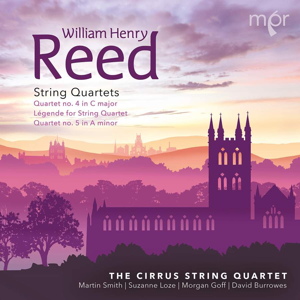
William Henry Reed (1875-1942)
String Quartet No.4 in C major (1913)
Légende for String Quartet (1922-23)
String Quartet No.5 in A minor (1915)
Cirrus String Quartet (Martin Smith, Suzanne Loze (violins), Morgan Goff (viola), David Burrows (cello))
rec. 2022, Pamoja Hall, The Space, Sevenoaks School, UK
MPR MPR114 [67]
I’ve only ever come across the name William Henry “Billy” Reed in connection with Elgar. In 1912 Reed was appointed leader of the London Symphony Orchestra, and it was in that capacity he met the composer, who ”…..never failed to speak with me………..always finding something friendly and encouraging to say”. Elgar sought Reed’s advice when he was composing his violin concerto, and the violinist gave a run-through of it privately to some of the composer’s friends. He was also involved in Elgar’s late chamber music trilogy, premiering the Violin Sonata and participating in the first performances of the String Quartet and Piano Quintet.
It came as a surprise to learn that Reed was a composer in his own right. He can be credited with a roster of compositions which include orchestral works, music for violin and viola, chamber music and songs. Regarding his chamber music, only the String Quartet No. 5 has seen publication. This was the work that set the Cirrus String Quartet on its journey of discovery. Being drawn to the music’s individuality and “distinctive English voice”, they decided to explore further. Their searches yielded fruitful results, with their locating the manuscript scores and parts of the String Quartet No. 4 and the Légende for String Quartet in the library of the Royal College of Music. As a point of interest, the first movement of a Quartet in F survives in the library of the Royal Academy of Music, Reed’s alma mater. However, the remaining three movements, documented to have received a performance, are lost. So, too, are Quartets 2 and 3.
The String Quartet No.4 in C major was written in 1913 and bears a dedication to the Wessely Quartet. The ensemble performed the work twice later in November of that year to at least one positive review. The latter performance was a private concert at the Royal Academy of Music in London. Cast in four movements, the opener begins in carefree manner, in what I can only describe as a sort of bucolic landscape. Yet there are wistful elements weaved into the narrative. The slow movement is titled Ritornello and I agree totally with the note writer, Martin Smith, that it has a certain similarity to Vaughan Williams’ Tallis Fantasia in its semi-modality, albeit in a minor key. The beginning of the third movement trots along without a care in the world before Reed ratchets up the pace into a sprightly scherzo. The finale has a sombre and doleful introduction marked Adagio con espressione before the demeanour transforms into an Allegro Molto both joyous and affable.
Two years later Reed submitted his String Quartet No.5 in A minor for the Walter Wilson Cobbett chamber music competition for British composers, run five times between 1905 and 1919. In 1915 the rules stipulated that the work could either be written in the usual Phantasy form, a structure devised by Cobbett himself, or the traditional four-movement form. Reed opted for the latter. Each of the four parts had to be of equal importance. The work took second prize. It received several performances that year by Reed’s own quartet. The first movement has driving rhythms, alternating with some luminous light textures. The second movement is likewise driven and urgent, but remains light on its feet. The solo cello ushers in the slow movement, and confers an elegiac quality on proceedings. The mood is one of longing and lament. The sombre vein is carried over into the final movement before the tenor lightens with more smiling elements.
The Légende is structured in two movements dating from 1922-23. Reed had an old friend an ex-pupil called Jessie Snow. In 1918 he penned a violin concerto for her, and a year later accompanied her in a performance of Elgar’s Violin Sonata. Snow formed a string quartet in 1922 and it’s speculated that the Légende movements would give the newly formed ensemble something to premiere. For me, movement one is the finer of the two. It evokes an Elysian idyll of radiant calm, and one hears faint echoes of Vaughan Williams lingering in the background. It gradually mutates into a slow lingering waltz. The second movement couldn’t be more different, buoyant, angular and mercurial. It ends with a downward richochet glissando and some harmonics thrown in for good measure, no doubt a nod to Snow’s violinistic skills.
This crowd-funding venture has been a labour of love for producer Mike Purton, whose “label’s mission is to bring unfairly forgotten and overlooked music to life with the finest musicians and highest production values”. All of the works here are receiving world premiere recordings. The Cirrus String Quartet perform with enthusiasm, style and enthusiasm, and are ardent advocates for this repertoire. The beautifully produced booklet contains some illuminating notes by Martin Smith, in addition to some photographs of Reed. For those eager explore new territory, all I’ll say is – go for it.
Stephen Greenbank
Previous review: Nick Barnard
Help us financially by purchasing from





















